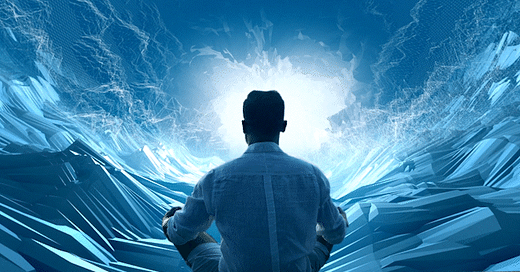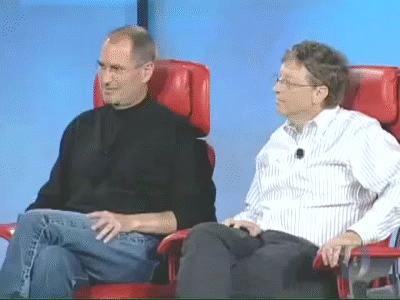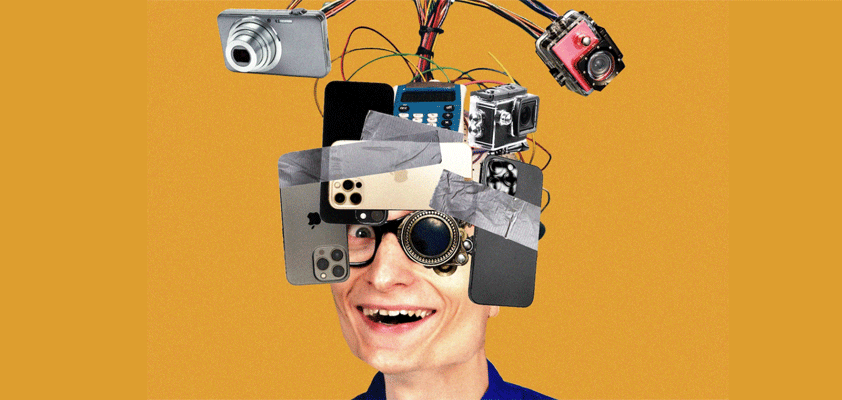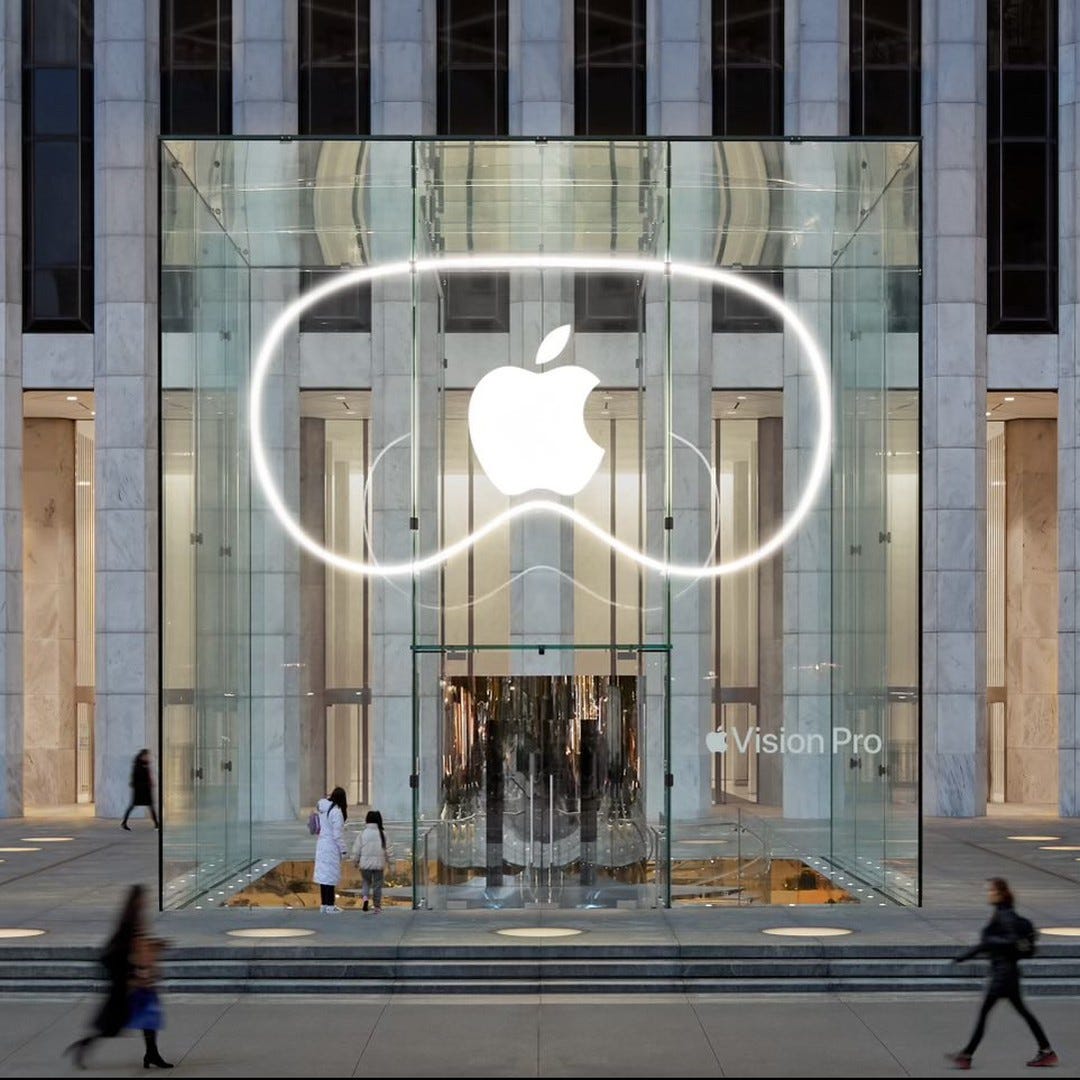AI: Tim 'Apple' Cook's Vision Pro, Origin Story
...long-term tech bets are contentious journeys: decades and billions on inspired hunches
Well, most of us early, early adopters get the Apple Vision Pro in our hands tomorrow, Friday, February 2nd. We parted with $3,499 often with the indulgence of our better halves, who’re not quite sure why we’re so gung-ho on trying something that looks good on NOBODY’s face.
There it is finally, on Apple CEO Tim Cook’s face below, on the cover of Vanity Fair, in an Apple Vision Pro origin story penned by noted author and journalist Nick Bilton:
In the ‘The Bigger Picture’ two Sundays ago, I recounted how Steve Jobs back in 1979, over 45 years ago, saw the first instance of a new type of personal computer computer at the iconic Xerox PARC facility in Silicon Valley. And after seeing their implementation of a Graphical User Interface (GUI), and a prototypical ‘Mouse’, had an epiphany, according to Silicon Valley myth. He exclaimed in ten minutes that
‘Within ten minutes, it was obvious to me that all computers would work this way”.
The piece goes onto to recount how Bill Gates now 68, eleven years past Steve leaving us at 56, had a similar experience in September 2022. That’s when he upon experienced OpenAI’s ChatGPT at his house in Seattle, guided by OpenAI founder/CEO Sam Altman of course. As I went onto say in that post:
“For most of us, ‘within ten minutes’ of interacting with ChatGPT, it was obvious ‘that all computers would work this way’. Especially after experiencing the ‘multimodal’ versions of ChatGPT and other AI chat agents of late. And thus we are on yet another wild tech ride in these early days of the AI Tech Wave. In all their emerging shapes and forms.”
In the Vanity Fair cover story, Tim ‘Apple’ Cook at 63, has his similar moment with the pre-precursor to the Vision Pro. Nick Bilton paints it thus:
“The first time Tim Cook experienced the Apple Vision Pro, it wasn’t called the Apple Vision Pro. It was years ago; maybe six, seven, or even eight. Before the company built Apple Park, where we’re sitting right now, at a bleached oak table in this incredible circular edifice of a building clad in miles of curved glass. It’s been raining, and the clouds are clearing over the pine trees and the rows of citrus and maple trees, and the sun is reflecting off the pond in the meadow, and it’s kind of mesmerizing. And Cook’s telling me about that time, all those years ago, in his dulcet Robertsdale, Alabama, accent, when he first saw it.”
“It was at Mariani 1, a nondescript low-rise building on the edge of the old Infinite Loop campus with blacked-out windows. This place is so secret, it’s known as one of Apple’s “black ops” facilities. Nearly all of the thousands of employees who work at Apple have never set foot inside one. There are multiple layers of doors that lock behind and in front of you. But Cook is the CEO and can go anywhere. So he strolls past restricted rooms where foldable iPhones and MacBooks with retractable keyboards or transparent televisions were dreamed up. Where these devices, almost all of which will never leave this building, are stored in locked Pelican cases inside locked cupboards.”
One day, this will likely be in a movie, or an Apple TV+ show:
Not quite like this illustration from a different piece, but close in spirit:
If you’ve read and watched the wide range of reviews and videos on the internet already, this experience of being on the Moon will soon be available to the rest of us. Either willing to shell out $3,499 for the privilege, or line up at an Apple Store soon for a demo.
And it does seem as James Cameron puts it in the piece, (yes, that James Cameron):
“I would say my experience was religious,” the director James Cameron told me when I asked him about his first encounter with the Apple Vision Pro. “I was skeptical at first. I don’t bow down before the great god of Apple, but I was really, really blown away.”
““I think it’s not evolutionary; it’s revolutionary,” Cameron said to me when I told him about my experience. “And I’m speaking as someone who has worked in VR for 18 years.” He explained that the reason it looks so real is because the Apple Vision Pro is writing a 4K image into my eyes. “That’s the equivalent of the resolution of a 75-inch TV into each of your eyeballs—23 million pixels.”
“To put that into perspective, the average 4K television has around 8 million pixels. Apple engineers didn’t slice off a rectangle from the corner of a 4K display and put it in the Apple Vision Pro. They somehow compressed twice as many pixels into a space as small as your eyeball. This, to people like Cameron who have been working in this space for two decades, “solves every problem.”
But as the piece and other reviews goes into the near-term realities of the Vision Pro:
“But even with all this wonder, with 23 million pixels that are so clear and crisp that you can’t tell reality from a digital composite of it, there are some problems Apple hasn’t solved—at least not yet.”
I would recommend reading the full Vanity Fair piece for those so inclined. And of all the reviews out there, I’d highlight these by Nilay Patel of the Verge, Joanna Stern by the Wall Street Journal, and of course the inimitable Marques Brownlee (aka MKBHD) of YouTube fame. For those looking for more, I’d also highlight this meta-review by my friend Om Malik, his summary of the few “Magical Moments”, as well as more time reading and watching content on the Vision Pro. He’s also quoted in the Vanity Fair article.
For my take on the broader implications of the Vision Pro for Apple, I’d also highlight this recent piece. All above recommended for weekend reading and/or watching on the Vision Pro. Their reactions also echoed the sentiment that consuming digital content without the Vision Pro, rang hollow after even a short time with it. To be sure, there are negative takes on the device, be it the price, the weight, and other compromises with the product. The debate will continue in earnest all this year at least. And more of us will get a chance to make up our own minds as well.
Historically, most iconic new technology, from the TV, to the VCR, to the cell phone, and of course the Apple Mac computer, start out as being viewed as too expensive and/or inadequate on launch. Along with long laundry lists of issues it had, and things we wished it could do. And of course endless debates on ‘what it’s actually good for’. The Steve Jobs driven Macintosh computer by the way, just celebrated its 40th anniversary a week ago. We know now what it was good for and how it dented the industry at large.
As I outlined in this post last July, those products and more all cost more than the Vision Pro’s $3,499 in today’s dollars. The Mac of 40 years ago was priced at $2,495 in 1984, or $7,300 in 2024 dollars.
That’s TWO Vision Pros, for your better half and yourself. Or to put one away unopened as a possible collectible for the next generation.
To see how their world of Then, had some roots in the intense Dreaming and Doing in the world of Now. And all that had to be endured over decades to get from here to there.
As I said at the outset above, most long-term bets in technology are just that. Often decades and billions on an inspired hunch, with the ultimate rewards often accruing to other companies and later pioneers. But society generally benefits the most from it all.
As for the Apple Vision Pro in the here and now, I’ll likely have more to say on the subject soon. After some hands-on time with it in the days to come. Stay tuned.











